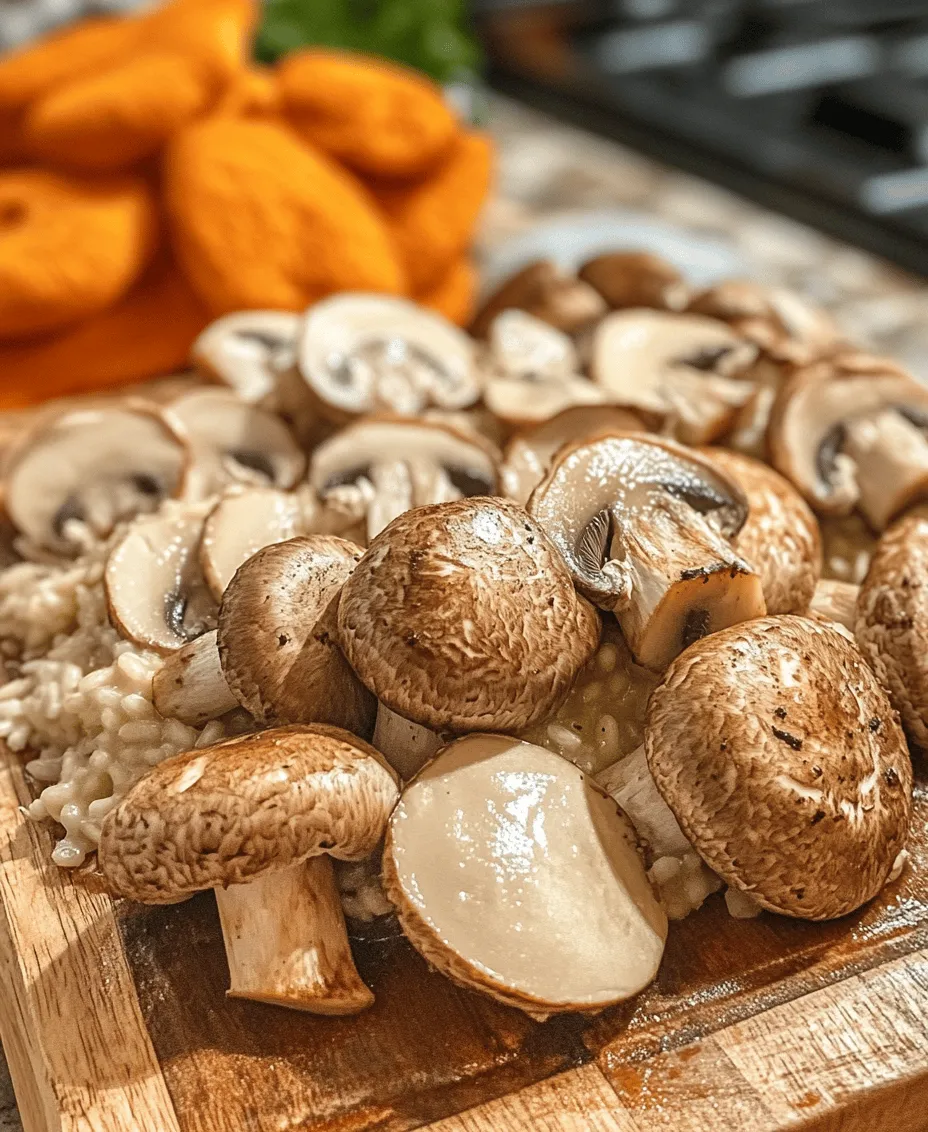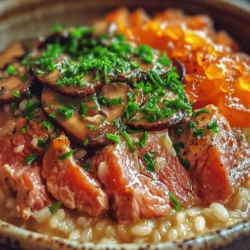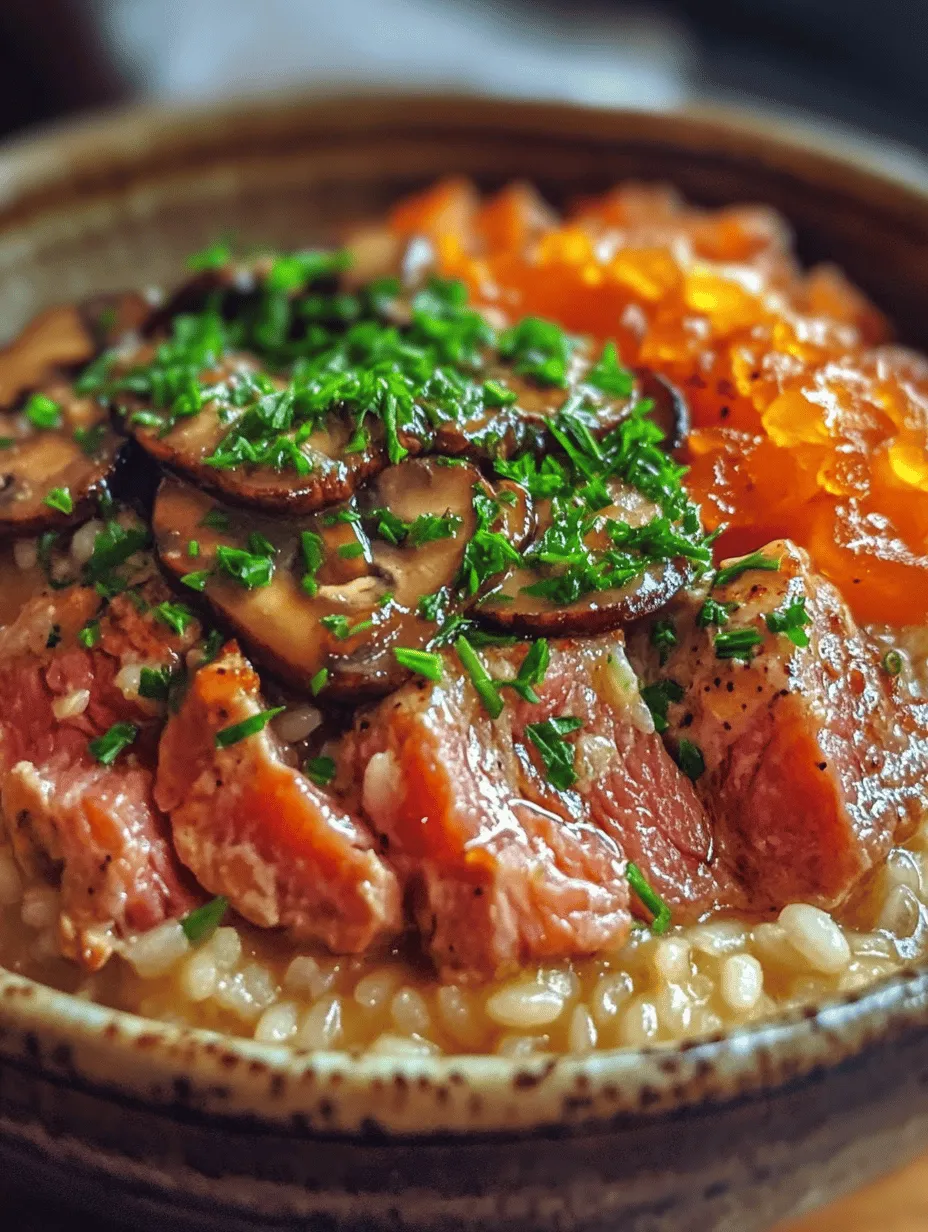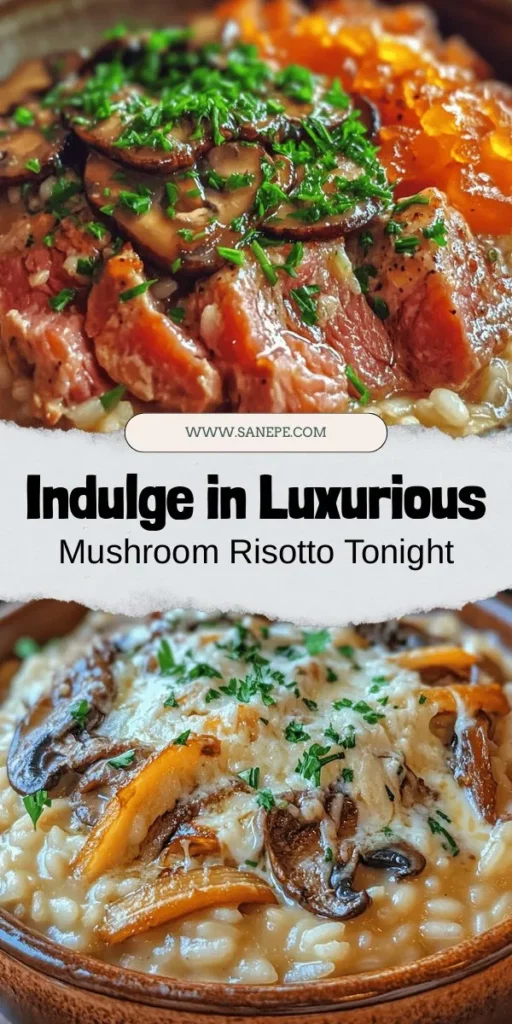Introduction
When it comes to comforting yet elegant meals, few dishes can rival the allure of creamy mushroom risotto. This Italian classic is not only a feast for the senses but also a testament to the beauty of simple, high-quality ingredients. Picture a warm bowl of Arborio rice, lovingly stirred to creamy perfection, enriched with the earthy flavors of sautéed mushrooms, aromatic garlic, and a splash of white wine. Whether you’re hosting a dinner party or simply treating yourself to a cozy night in, mushroom risotto promises to deliver a heartwarming experience that lingers long after the last bite.
The key to a truly luxurious mushroom risotto lies in its ingredients. Using fresh, high-quality components elevates the dish from ordinary to extraordinary. Select mushrooms such as cremini, shiitake, and portobello to create a rich medley of flavors. Coupled with the creamy texture of heavy cream and the nutty essence of freshly grated Parmesan cheese, this dish embodies indulgence. Moreover, the nutritional benefits of mushrooms—packed with vitamins, minerals, and antioxidants—make this risotto not just a delicious option but a nourishing one as well.
Understanding Risotto
Definition and Origins of Risotto
Risotto is a staple of Northern Italian cuisine, renowned for its creamy texture and deep flavors. The dish has its roots in the rice-growing regions of Italy, particularly in Lombardy and Piedmont. Traditionally, risotto is made using specific varieties of rice that absorb liquid and release starch, creating a velvety consistency. The dish’s history can be traced back to the late 19th century, becoming a popular comfort food throughout Italy and beyond.
Culturally, risotto is more than just a meal; it represents the Italian ethos of using simple, seasonal ingredients and transforming them into something special through careful cooking techniques. It is often served as a primo (first course) in Italian meals, allowing diners to savor each bite before moving on to the main course.
Types of Rice Used in Risotto
The most common rice used for risotto is Arborio rice, known for its short, plump grains and high starch content. This unique composition is what makes Arborio rice ideal for risotto: as it cooks, the rice releases starch into the cooking liquid, resulting in a creamy, luxurious texture. Other types of rice used for risotto include Carnaroli and Vialone Nano, each offering its distinct qualities. However, Arborio remains the most accessible and widely used variety, making it a staple in many home kitchens.
The Role of Slow Cooking
One of the hallmarks of a great risotto is the slow and patient cooking process. Unlike traditional boiling methods, risotto requires a gentle simmer, allowing the rice to absorb the liquid gradually. This technique not only enhances the flavors but also develops the dish’s signature creamy texture. The process involves adding warm broth incrementally, stirring frequently, and allowing the rice to soak up the liquid before adding more. This method may require some patience, but the results are well worth the effort, transforming simple ingredients into a luxurious culinary experience.
Key Ingredients for Luxurious Creamy Mushroom Risotto
Arborio Rice
At the heart of every risotto is the rice, and Arborio plays a crucial role in achieving the desired creaminess. Its unique texture allows it to absorb flavors while maintaining a slight bite, known as “al dente.” When cooked properly, Arborio rice becomes creamy without losing its shape, making it the ideal choice for this dish. Look for high-quality Arborio rice at your local grocery store or specialty food market to ensure the best results.
Broth Options
The choice of broth can significantly impact the flavor profile of your risotto. While vegetable broth is a popular option for a vegetarian dish, chicken broth adds a richness that complements the earthy flavors of the mushrooms. For the best results, consider making your own broth from scratch, using fresh vegetables, herbs, and bones (if using chicken). This homemade broth will infuse your risotto with deep, complex flavors that store-bought versions may lack.
The Impact of White Wine
A splash of white wine is an essential ingredient in mushroom risotto, as it enhances the dish’s overall flavor. The acidity of the wine helps to balance the richness of the cream and cheese while adding a layer of complexity to the dish. When selecting a wine, opt for a dry variety that you enjoy drinking—this will ensure that the flavors meld beautifully in the final dish.
Mushroom Medley
Mushrooms are the star of this risotto, providing a rich umami flavor that elevates the dish. Using a medley of mushrooms, such as cremini, shiitake, and portobello, adds depth and variety to the flavor profile. Each type of mushroom brings its unique characteristics: cremini offers a mild earthiness, shiitake lends a meaty texture, and portobello adds a robust, hearty flavor. Feel free to experiment with different varieties to discover your perfect combination.
Heavy Cream and Parmesan Cheese
The creamy indulgence of this risotto comes from the addition of heavy cream and freshly grated Parmesan cheese. These dairy components not only enhance the dish’s richness but also contribute to its velvety texture. Using high-quality Parmesan cheese ensures that the flavors are pronounced and authentic. Grate the cheese fresh from a block for the best taste and meltability.
Aromatics
Aromatic ingredients like garlic, onion, and thyme are essential for building flavor layers in your risotto. Sautéing finely chopped onions and minced garlic in butter or olive oil creates a fragrant base for the dish. Adding fresh thyme introduces herbal notes that complement the earthiness of the mushrooms, resulting in a harmonious flavor profile. Don’t be afraid to adjust the quantities of these aromatics to suit your taste preferences.
Step-by-Step Guide to Making Luxurious Creamy Mushroom Risotto
Now that we have a solid understanding of the ingredients and their importance, let’s delve into the step-by-step process of creating a luxurious creamy mushroom risotto. This section will provide a detailed guide to help you master this elegant dish, ensuring a satisfying and fulfilling cooking experience.
1. Gather Your Ingredients: Begin by assembling all your ingredients. You’ll need Arborio rice, a selection of fresh mushrooms, broth (either vegetable or chicken), white wine, heavy cream, Parmesan cheese, garlic, onion, thyme, and olive oil or butter.
2. Prepare the Broth: If you’re making your own broth, start by simmering your chosen ingredients in water, allowing them to infuse their flavors. Keep the broth warm on the stove throughout the cooking process, as adding cold broth can disrupt the cooking temperature.
3. Sauté the Aromatics: In a large skillet or saucepan, heat olive oil or butter over medium heat. Add finely chopped onion and sauté until translucent. Incorporate minced garlic and fresh thyme, cooking for an additional minute until fragrant.
4. Cook the Mushrooms: Add your medley of mushrooms to the skillet, stirring occasionally until they release their moisture and begin to brown. This process will enhance their flavor and add richness to your risotto.
5. Toast the Rice: Once the mushrooms are cooked, add Arborio rice to the skillet. Stir well to coat the rice with the oil and aromatics. Toasting the rice for a couple of minutes will help develop its flavor and prepare it for absorbing the broth.
6. Deglaze with Wine: Pour in a splash of white wine, stirring continuously until it is fully absorbed by the rice. This step not only adds flavor but also allows you to scrape up any browned bits from the bottom of the pan, contributing to the dish’s overall taste.
7. Add the Broth Gradually: Begin adding warm broth to the skillet, one ladle at a time. Stir gently and continuously, allowing the rice to absorb the liquid before adding more. This process may take around 20-25 minutes, and patience is key to achieving the perfect creamy consistency.
As you progress through these initial steps, you’ll begin to appreciate the transformative process of creating mushroom risotto. By carefully managing your ingredients and technique, you’ll soon find yourself on the path to a luxurious and delicious meal that embodies the heart of Italian cuisine.

Preparation
To create a luxurious creamy mushroom risotto, preparation is key. Begin by gathering all the ingredients to ensure a smooth cooking process. You’ll need Arborio rice, a selection of fresh mushrooms, shallots or onions, garlic, vegetable or chicken broth, white wine, heavy cream, Parmesan cheese, and seasonings like salt and pepper.
Chopping Ingredients: Start by finely chopping the onions and garlic. Aim for a uniform size to ensure they cook evenly. For the mushrooms, slice them evenly as well. This allows them to release their moisture uniformly and caramelize beautifully. Measure out the Arborio rice, broth, and cream in advance, as this will help you maintain a steady workflow.
Cooking the Aromatics
Next, the cooking of the aromatics is crucial to developing the rich flavors that will form the base of your risotto. Heat a generous amount of olive oil in a large, heavy-bottomed pot or pan over medium heat. Add the finely chopped onions or shallots and sauté them until they become translucent, which usually takes about 3-5 minutes. Next, add the minced garlic and cook for an additional minute, being careful not to let it burn, as burnt garlic can impart a bitter taste to your risotto. This step builds the aromatic foundation for your dish.
Incorporating Mushrooms
Once your aromatics are ready, it’s time to incorporate the mushrooms. Add the sliced mushrooms to the pan, ensuring they are spread out in a single layer. This allows them to sear and develop a nice golden color. Cook the mushrooms for about 5-7 minutes, stirring occasionally, until they release their moisture and begin to brown. This caramelization enhances the umami flavor, making your risotto deeply savory.
Toasting the Rice
After the mushrooms have cooked down, it’s essential to toast the Arborio rice. This step is often overlooked but is vital for achieving the right texture. Add the rice to the pot, stirring it into the mushroom mixture. Cook for about 2-3 minutes, allowing the rice to absorb the flavors and become slightly translucent at the edges. Toasting the rice helps to develop its nutty flavor and prepares it to absorb the broth, ensuring a creamy consistency.
The Gradual Addition of Broth
Now comes the most important part of making risotto: the gradual addition of broth. Begin by pouring in a ladleful of warm broth, stirring constantly. The key to a creamy risotto is to add the broth slowly, one ladle at a time, allowing the rice to absorb the liquid fully before adding more. This process, known as “stirring,” releases the starches from the rice, creating the signature creaminess of risotto. Continue this process for about 18-20 minutes, or until the rice is al dente. Taste frequently to check for doneness.
Achieving the Perfect Consistency
As you near the end of the cooking process, it’s crucial to recognize the right consistency for your risotto. The rice should be tender but still have a slight bite to it. If you find that your risotto is too thick, add a bit more broth or water to loosen it up. The final texture should be creamy yet flowing, with the risotto holding its shape on the plate but still being slightly saucy.
Final Touches
Once the rice has reached the desired texture, it’s time for the final touches that elevate your risotto to a luxurious level. Remove the pot from heat and stir in a generous splash of heavy cream, a few tablespoons of butter, and freshly grated Parmesan cheese. These ingredients not only enhance the flavor but also contribute to the creamy mouthfeel. Season with salt and pepper to taste, and stir everything until well combined.
Serving Suggestions and Pairings
Presentation Tips: When serving your creamy mushroom risotto, presentation is key. Use a shallow bowl to showcase the risotto, allowing for an ample surface area. A careful mound of risotto topped with a drizzle of olive oil can create an inviting appearance.
Garnishes: Fresh herbs play a significant role in both enhancing flavor and elevating presentation. Sprinkle chopped fresh parsley or chives over the risotto just before serving. For an added touch, consider shaving some extra Parmesan on top or adding a few sautéed mushroom slices for visual appeal.
Wine Pairings: When it comes to selecting a wine to accompany your risotto, opt for a light, crisp white wine. A Pinot Grigio or Sauvignon Blanc pairs beautifully with the creamy texture and earthy flavors of the dish. The acidity in these wines complements the richness of the risotto, enhancing the overall dining experience.
Nutritional Information
The nutritional content of creamy mushroom risotto can vary based on the ingredients used, but on average, a serving contains approximately 400-500 calories, with about 12-15 grams of protein, 20-25 grams of fat, and 50-60 grams of carbohydrates. It also provides essential vitamins and minerals, including B vitamins from the mushrooms, calcium from the cheese, and healthy fats from the cream and butter.
Health Benefits of Main Ingredients:
– Mushrooms: Rich in antioxidants, mushrooms provide immune support and are a good source of vitamins B and D.
– Arborio Rice: As a whole grain, Arborio rice offers fiber and essential nutrients, promoting digestive health.
– Dairy: Used in moderation, dairy products like cheese and cream can provide a good source of calcium and protein, contributing to bone health.
Conclusion
In summary, this luxurious creamy mushroom risotto is not only an elegant dish but also a simple one to master. The careful attention to detail in preparation, cooking, and presentation transforms basic ingredients into a gourmet experience that can be enjoyed on any occasion. Cooking is about sharing joy and creating memorable moments with loved ones, and this risotto is an ideal centerpiece for gatherings or intimate dinners.
Feel encouraged to experiment with variations by incorporating seasonal vegetables, different types of cheese, or even proteins like chicken or shrimp. While the recipe holds its core essence, adapting it to your taste will make it uniquely yours. Enjoy the process of cooking and savoring this delightful dish with family and friends, creating cherished memories around the table.


